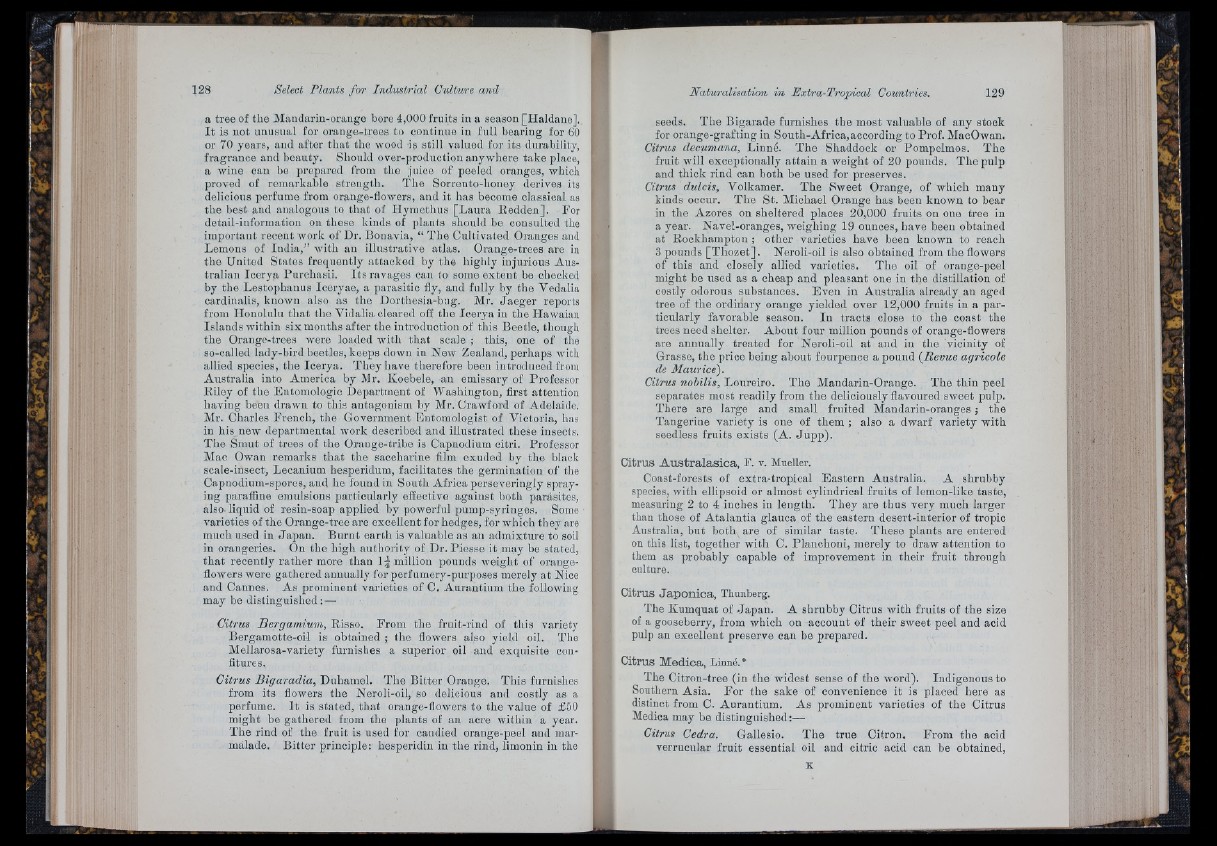
a tree of the Mandarin-orange bore 4,000 fruits in a season [Haldane],
I t is not unusual for orange-trees to continue in full bearing for 60
or 70 years, and after that the wood is still valued for its durability,
fragrance and beauty. Should over-production anywhere take place,
a wine can be prepared from tlie juice of peeled oranges, wliioh
proved of remarkable strengtli. The Sorrento-lionoy derives ita
delicious perfume from orauge-flowers, and it has become classical as
the best and analogous to th a t of Hymethus [Laura Redden]. For
detail-iuformation on these kinds of plants should bo consulted the
important recent work of Dr. Bonavia, “ The Cultivated Oranges and
Lemons of India,” with an illustrative atlas. Orange-trees are in
the United States frequently attacked by the highly injurious Australian
Icerya Purcliasii. Its ravages can to some extent be checked
by the Lestophanus Iceryae, a parasitic fly, aud fully by the Vedalia
cardinalis, known also as the Dorthosia-bug. Mr. Ja eg e r reports
from Honolulu tliat tlie Vidalia cleared off tlie Icerya iu the Hawaiun
Islands within six months after the introduction of this Beetle, though
the Orange-trees were loaded with that scale ; tliis, one of the
so-called lady-bird beetles, keeps down in New Zealand, perhaps with
allied species, the Icerya. They have therefore been introduced from
Australia into America by Mr. Koebele, an emissary of Professor
Riley of the Entomologie Department of Washington, first attention
liaving been drawn to this antagonism by Mr. Crawford of Adelaide.
Mr. Charles French, tlie Government Entomologist of Victoria, has
in his new departmental work described and illustrated these insects.
The Smut of trees of the Oraiige-tribe is Capnodium citri. Professor
Mae Owau remarks that tlie saccharine film exuded by the black
scale-iusect, Lecanium hesperidum, facilitates tlie germination of the
Capnodium-sporos, and he found in South Africa perseveriiigly spraying
paraffine emulsions particularly effective against both parásitos,
also liquid of resin-soap applied by powerful pump-syriiiges. Some
varieties of the Orange-tree are excellent for hedges, for which they are
much used in Japan. Burnt earth is valuable as an admixture to soil
in orangeries. On the high authority of Dr. Piesse it may be stated,
th a t recently rather more than 1¿ million pounds weight of orange-
flowers were gathered annually for perfumery-purposes merely a t Nice
and Cannes. As prominent varieties of C. Aurantium the following
may be distinguished: —
Citrus Bergamium, Risso. From the fruit-rind of this variety
Bergamotte-oil is obtained ; the flowers also yield oil. The
Mellarosa-variety furnishes a superior oil aud exquisite confitures.
Citrus Bigaradia, Duhamel. The Bitter Orange. This furnishes
from its flowers the Neroli-oil, so delicious and costly as a
perfume. I t is stated, th a t orange-flowers to the value of £50
miglit be gathered from the plants of an acre within a year.
The rind of the fruit is used for candied orange-peel and marmalade.
Bitter principle: hespcridin in the rind, limonin in the
seeds. The Bigarade furnishes the most valuable of any stock
for orange-grafting in South-Africa,according to Prof. MacOwan.
Citrus decumana, Linné. The Shaddock or Pompelmos. The
fruit will exceptionally attain a weight of 20 pounds. The pulp
and thick rind can both be used for preserves.
Citrus dulcis, Volkamer. The Sweet Orange, of which many
kinds occur. The St. Michael Orange has been known to bear
in the Azores on sheltered places 20,000 fruits on one tree in
a year. Navel-oranges, weighing 19 ounces, have been obtained
at Rockhampton ; other varieties have been known to reach
3 pounds [Thozet
Neroli-oil is also obtained from the flowers
of this and close
!ly allied varieties. The oil of orange-peel
might be used as a cheap and pleasant one in the distillation of
costly odorous substances. Even in Australia already an aged
tree of the ordinary orange yielded over 12,000 fruits in a particularly
favorable season. In tracts close to the coast the
trees need shelter. About four million pounds of orange-flowers
are annually treated for Neroli-oil at and in tlie vicinity of
Grasse, the price being abont fourpeuoe a pound (Revue agricole
de Maurice).
Citrus nobilis, Loureiro. The Mandarin-Orange. The thin peel
separates most readily from the deliciously flavoured sweet pulp.
There are iarge and small fruited Maudariu-oranges ; the
Tangerine variety is one of them ; also a dwarf variety with
seedless fruits exists (A. Jupp).
C itru s A u s tr a l a s ic a , F. v. Mueller.
Coast-forests of extra-tropical Eastern Australia. A shrubby
species, with ellipsoid or almost cylindrical fruits of lemon-like taste,
measuring 2 to 4 inches in length. They are thus very much larger
than those of Atalantia glauca of the eastern desert-interior of tropic
Australia, but both are of similar taste. These plants are entered
on this list, together with C. Planchoni, merely to draw attention to
them as probably capable of improvement in their fruit through
culture.
C itru s J a p ó n i c a , Thunberg.
The Kumquat of Japan. A shrubby Citrus with fruits of the size
of a gooseberry, from which on account of their sweet peel and acid
pulp an excellent preserve can be prepared.
C itru s M e d ic a , Linné.*
The Citron-tree (in the widest sense of the word). Indigenous to
Southern Asia. For the sake of convenience it is placed here as
distinct from C. Aurantium. As prominent varieties of the Citrus
Medica may be distinguished:—
Citrus Cedra. Gallesio. The true Citron. From the acid
verrucular fruit essential oil and citric acid can be obtained,
á